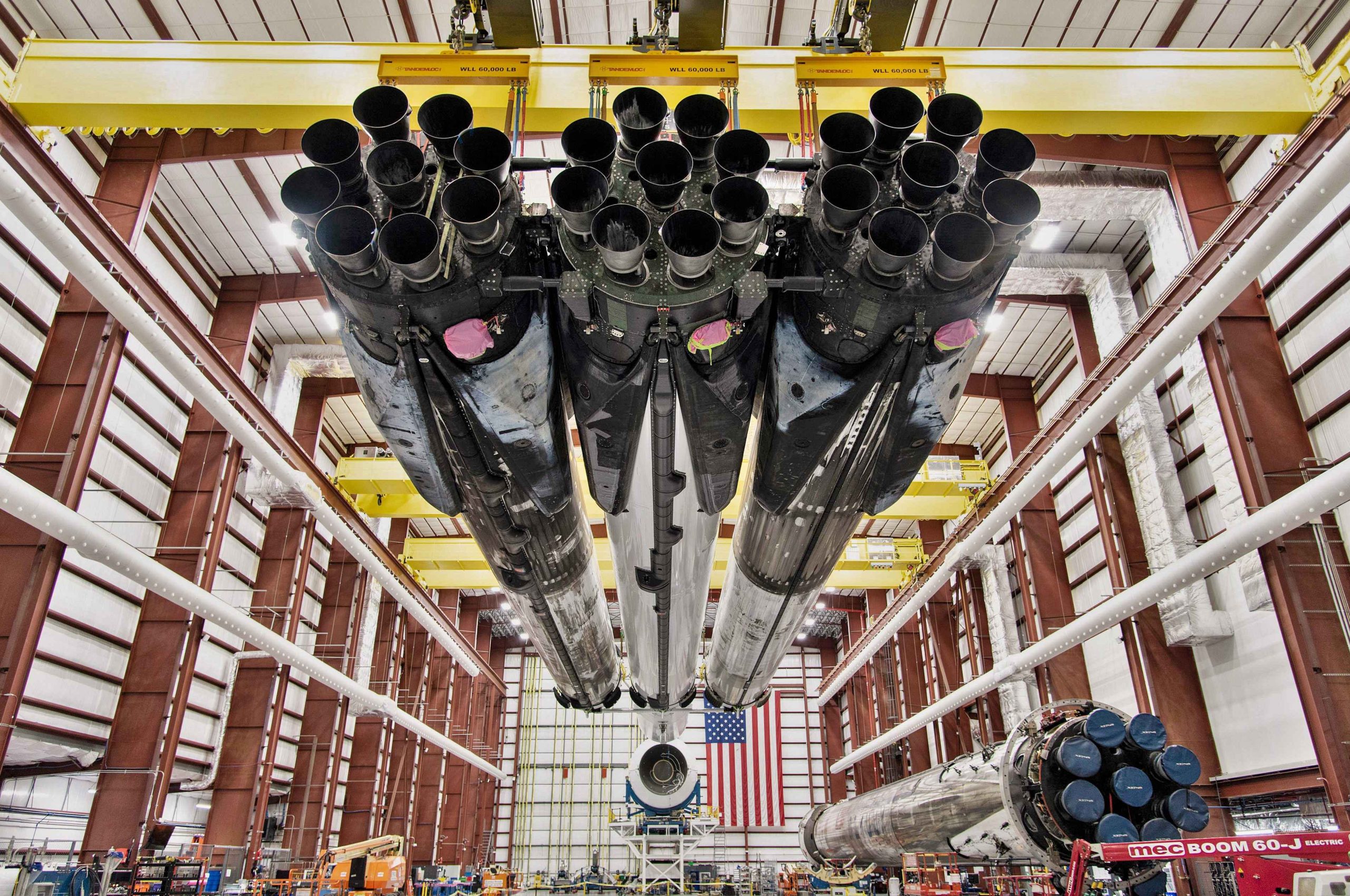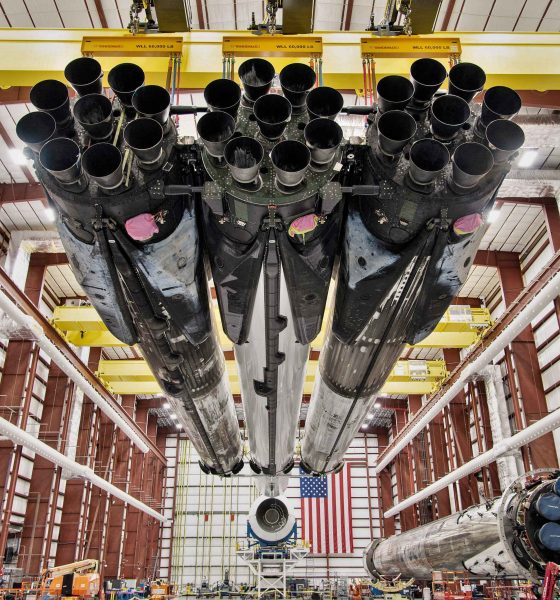

News
SpaceX Falcon Heavy launch contracts reach double digits after latest NASA win
For the third time in seven months, NASA has contracted SpaceX’s Falcon Heavy rocket to launch a high-value scientific spacecraft, raising the number of active contracts for the world’s most powerful rocket into the double digits.
In a twist that has become increasingly unsurprising, a spokesperson from SpaceX competitor United Launch Alliance (ULA) says that the company – the only other competitor for the contract – withdrew its bid because it had no more Atlas V rockets available. ULA announced earlier this year that it had officially stopped selling Atlas V launches, leaving a total of 29 more launches – all already reserved for specific customers – before the rocket is fully retired. Unfortunately for ULA, the Vulcan Centaur rocket it’s been developing to replace Atlas V and Delta IV since 2013 or 2014 is years behind schedule.
Somewhat inexplicably, even though ULA bid Vulcan to launch a high-value NASA payload in Q4 2024 as recently as this year, the company apparently didn’t feel that its next-gen rocket would be ready to launch a different payload in Q2 2024. In response, NASA’s only option to launch the GOES-U geostationary weather satellite was SpaceX’s offering, guaranteeing it the contract when ULA backed out of the competition.
Part of an 18-satellite fleet dating back to the 1970s, GOES-U will be the fourth and (as of now) final satellite in a modern extension of the GOES (Geostationary Operational Environmental Satellite) program contracted by NASA for NOAA in 2008. In 2013, GOES-T and GOES-U were added to the original GOES-R and GOES-S, nominally resulting in four satellites built by Lockheed Martin for an average of ~$350M each.
ULA or ULA-heritage rockets have launched all 18 GOES satellites to date and there was little reason to believe that wouldn’t continue until the end of the GOES-R series. However, as a result of ULA’s major Vulcan development delays, it appears that the company now finds itself temporarily incapable of competing for launch contracts. That makes it hard to judge whether SpaceX would have won GOES-U without ULA’s withdrawal, though it’s difficult to imagine ULA could have beat Falcon Heavy’s $153M contract price.
In one of the most unequivocal signs of SpaceX’s immense impact on even the launch contracts it lost, ULA’s first two GOES-R-series Atlas V launch contracts were each valued at $261M in 2021 dollars when they were awarded in 2013. In 2019, NASA again awarded ULA a contract to launch GOES-T on an identical Atlas V 541 rocket – but this time for just $177M (2021).
It’s unclear what kind of configuration Falcon Heavy will be in for its April 2024 GOES-U launch. For ULA’s GOES-R and GOES-S launches, Atlas V has delivered each ~5200 kg (~11,500 lb) weather satellite to an “optimized geosynchronous transfer orbit [GTO].” A bit like a middle ground between an elliptical GTO launch and a direct-to-geostationary-orbit (GEO) launch, both missions required Atlas V’s Centaur upper stage to perform three separate burn – and one after a three-hour coast. In theory, Falcon Heavy should be able to easily launch GOES-U to a similar orbit while allowing SpaceX to recover all three boosters, though it’s possible that safety margins will mean the center core is expended.
Regardless, Falcon Heavy continues to more than prove that SpaceX made the right choice by investing significantly more than $500M of its own money to develop the rocket. In 2021 alone, the rocket has secured three NASA launch contracts worth around $660M. In 2020, SpaceX won another ~$120M Falcon Heavy launch contract from NASA. All told, the rocket has now earned the company ten active launch contracts, including four or five in 2022 alone: ViaSat-3, USSF-52, NASA’ Psyche, USSF-67, and perhaps an Inmarsat commsat. In 2023, Falcon Heavy could launch Astrobotic’s first Griffin Moon lander with NASA’s VIPER rover, followed by GOES-U, Europa Clipper, and (though delays are very likely) two parts of NASA’s Gateway lunar space station.
Including USSF-44 (scheduled to launch next month) and assuming Inmarsat’s I-6 F2 commsat ends up on Falcon Heavy, the rocket now has ten launch contracts after winning GOES-U. Additionally, while the program appears to be in limbo, NASA did technically announce plans for SpaceX to launch at least two Dragon XL spacecraft on Falcon Heavy to resupply the lunar Gateway station – a total of 12 missions if those plans turn into tangible contracts.

News
Tesla FSD v14.2.2 is getting rave reviews from drivers
So far, early testers have reported buttery-smooth drives with confident performance, even at night or on twisty roads.

Tesla Full Self-Driving (Supervised) v14.2.2 is receiving positive reviews from owners, with several drivers praising the build’s lack of hesitation during lane changes and its smoother decision-making, among others.
The update, which started rolling out on Monday, also adds features like dynamic arrival pin adjustment. So far, early testers have reported buttery-smooth drives with confident performance, even at night or on twisty roads.
Owners highlight major improvements
Longtime Tesla owner and FSD user @BLKMDL3 shared a detailed 10-hour impression of FSD v14.2.2, noting that the system exhibited “zero lane change hesitation” and “extremely refined” lane choices. He praised Mad Max mode’s performance, stellar parking in locations including ticket dispensers, and impressive canyon runs even in dark conditions.
Fellow FSD user Dan Burkland reported an hour of FSD v14.2.2’s nighttime driving with “zero hesitations” and “buttery smooth” confidence reminiscent of Robotaxi rides in areas such as Austin, Texas. Veteran FSD user Whole Mars Catalog also demonstrated voice navigation via Grok, while Tesla owner Devin Olsen completed a nearly two-hour drive with FSD v14.2.2 in heavy traffic and rain with strong performance.
Closer to unsupervised
FSD has been receiving rave reviews, even from Tesla’s competitors. Xpeng CEO He Xiaopeng, for one, offered fresh praise for FSD v14.2 after visiting Silicon Valley. Following extended test drives of Tesla vehicles running the latest FSD software, He stated that the system has made major strides, reinforcing his view that Tesla’s approach to autonomy is indeed the proper path towards autonomy.
According to He, Tesla’s FSD has evolved from a smooth Level 2 advanced driver assistance system into what he described as a “near-Level 4” experience in terms of capabilities. While acknowledging that areas of improvement are still present, the Xpeng CEO stated that FSD’s current iteration significantly surpasses last year’s capabilities. He also reiterated his belief that Tesla’s strategy of using the same autonomous software and hardware architecture across private vehicles and robotaxis is the right long-term approach, as it would allow users to bypass intermediate autonomy stages and move closer to Level 4 functionality.
News
Elon Musk’s Grok AI to be used in U.S. War Department’s bespoke AI platform
The partnership aims to provide advanced capabilities to 3 million military and civilian personnel.

The U.S. Department of War announced Monday an agreement with Elon Musk’s xAI to embed the company’s frontier artificial intelligence systems, powered by the Grok family of models, into the department’s bespoke AI platform GenAI.mil.
The partnership aims to provide advanced capabilities to 3 million military and civilian personnel, with initial deployment targeted for early 2026 at Impact Level 5 (IL5) for secure handling of Controlled Unclassified Information.
xAI Integration
As noted by the War Department’s press release, GenAI.mil, its bespoke AI platform, will gain xAI for the Government’s suite of tools, which enable real-time global insights from the X platform for “decisive information advantage.” The rollout builds on xAI’s July launch of products for U.S. government customers, including federal, state, local, and national security use cases.
“Targeted for initial deployment in early 2026, this integration will allow all military and civilian personnel to use xAI’s capabilities at Impact Level 5 (IL5), enabling the secure handling of Controlled Unclassified Information (CUI) in daily workflows. Users will also gain access to real‑time global insights from the X platform, providing War Department personnel with a decisive information advantage,” the Department of War wrote in a press release.
Strategic advantages
The deal marks another step in the Department of War’s efforts to use cutting-edge AI in its operations. xAI, for its part, highlighted that its tools can support administrative tasks at the federal, state and local levels, as well as “critical mission use cases” at the front line of military operations.
“The War Department will continue scaling an AI ecosystem built for speed, security, and decision superiority. Newly IL5-certified capabilities will empower every aspect of the Department’s workforce, turning AI into a daily operational asset. This announcement marks another milestone in America’s AI revolution, and the War Department is driving that momentum forward,” the War Department noted.
News
Tesla FSD (Supervised) v14.2.2 starts rolling out
The update focuses on smoother real-world performance, better obstacle awareness, and precise end-of-trip routing, among other improvements.

Tesla has started rolling out Full Self-Driving (Supervised) v14.2.2, bringing further refinements to its most advanced driver-assist system. The new FSD update focuses on smoother real-world performance, better obstacle awareness, and precise end-of-trip routing, among other improvements.
Key FSD v14.2.2 improvements
As noted by Not a Tesla App, FSD v14.2.2 upgrades the vision encoder neural network with higher resolution features, enhancing detection of emergency vehicles, road obstacles, and human gestures. New Arrival Options let users select preferred drop-off styles, such as Parking Lot, Street, Driveway, Parking Garage, or Curbside, with the navigation pin automatically adjusting to the user’s ideal spot for precision.
Other additions include pulling over for emergency vehicles, real-time vision-based detours for blocked roads, improved gate and debris handling, and extreme Speed Profiles for customized driving styles. Reliability gains cover fault recovery, residue alerts on the windshield, and automatic narrow-field camera washing for new 2026 Model Y units.
FSD v14.2.2 also boosts unprotected turns, lane changes, cut-ins, and school bus scenarios, among other things. Tesla also noted that users’ FSD statistics will be saved under Controls > Autopilot, which should help drivers easily view how much they are using FSD in their daily drives.
Key FSD v14.2.2 release notes
Full Self-Driving (Supervised) v14.2.2 includes:
- Upgraded the neural network vision encoder, leveraging higher resolution features to further improve scenarios like handling emergency vehicles, obstacles on the road, and human gestures.
- Added Arrival Options for you to select where FSD should park: in a Parking Lot, on the Street, in a Driveway, in a Parking Garage, or at the Curbside.
- Added handling to pull over or yield for emergency vehicles (e.g. police cars, fire trucks, ambulances).
- Added navigation and routing into the vision-based neural network for real-time handling of blocked roads and detours.
- Added additional Speed Profile to further customize driving style preference.
- Improved handling for static and dynamic gates.
- Improved offsetting for road debris (e.g. tires, tree branches, boxes).
- Improve handling of several scenarios, including unprotected turns, lane changes, vehicle cut-ins, and school buses.
- Improved FSD’s ability to manage system faults and recover smoothly from degraded operation for enhanced reliability.
- Added alerting for residue build-up on interior windshield that may impact front camera visibility. If affected, visit Service for cleaning!
- Added automatic narrow field washing to provide rapid and efficient front camera self-cleaning, and optimize aerodynamics wash at higher vehicle speed.
- Camera visibility can lead to increased attention monitoring sensitivity.
Upcoming Improvements:
- Overall smoothness and sentience.
- Parking spot selection and parking quality.








